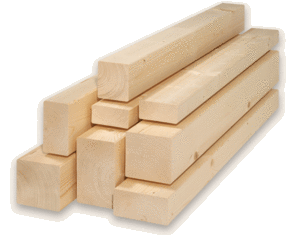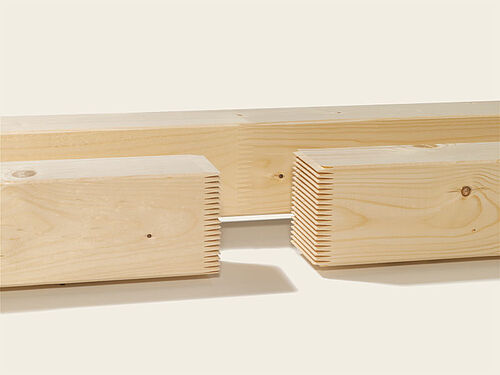Advantages of using KVH®
Kiln-dried structural timber components available in cross-sections of up to 14/26 cm
Dimensionally stable because they are kiln-dried to 15 ± 3% and cut on a split-heart basis (free-of-heart on request)
Two qualities are available:
- planed for exposed areas (Si)
- levelled for non-exposed areas (NSi)Meets higher requirements than those specified in German grading standard DIN 4074-1, or other European grading standards
Suitable especially for timber frame buildings and timber house construction
Minimum tender specification work because of a clear agreement on quality
Resistant to insects thanks to kiln drying; preservative treatment can be dispensed with in compliance with national standards for wood preservation
Economical preferred cross-sections and lengths of up to 13 m available for immediate delivery from stock; longer lengths available on request
Better than state-of-the-art
The requirements imposed on KVH® structural timber exceed the usual requirements set out in European grading regulations, and are aimed at achieving not only reliable strength values, but also a defined visual appearance. The maximum acceptable moisture content of 18%, for example, is lower than the limits set out in most national product standards, while the definition of surface quality is both more stringent – if defined at all in the national regulations – and covers more criteria. Reference can be made to the European standard EN 1912 to find out how KVH® structural timber graded by strength in accordance with German grading regulations or other Eurpean grading standards equates with the relevant European strength classes. Individual points are addressed in more detail below.
Kiln-dried and precisely cut
For modern timber buildings (residential buildings), a wood moisture content higher than 18% is far from ideal, and in some European countries, such as Germany, it is no longer acceptable at all. KVH® structural timber is kiln-dried to a maximum moisture content of 15 ± 3%. When the finger-joints are made, the moisture content of every single piece of wood is checked. Another special feature of KVH® structural timber is the method of cutting used. The square-sawn timber is cut on either a free-of-heart or split-heart basis, depending on the surface quality class. In split-heart cutting the log is sawn lengthwise along the ideal course of the pith, thereby minimizing the propensity for cracking. In free-of-heart cutting the heart plank, which is particularly susceptible to cracking, is also removed from the cross-section.
This special method of cutting ensures that KVH® exhibits outstanding dimensional stability and has little propensity for twisting.
Strength graded in accordance with German and European regulations
KVH® structural timber is in most cases strength graded according to the German grading standard DIN 4074. This German grading standard complies with the requirements of the European standard EN 14081-1 for strength grading. The normal German grading class for KVH® structural timber, which is S10 TS, corresponds to the European strength class C24 as defined in the European standard EN 1912.
However, the agreement on KVH® also allows grading according to other European grading standards, providing it corresponds to a European strength class.
Graded according to appearance
Depending on whether KVH® structural timber is to be used purely for its dimensional stability and low moisture content, or whether a high-quality appearance is also desired, two different surface quality classes ‒ KVH®-Si (exposed applications) and KVH®-NSi (non-exposed applications) ‒ are available to choose from. For exposed applications there are certain limits set for such features as knot size, knot condition, ingrown bark and crack widths. The grading criteria can be found in section "Requirements to be met by KVH®"
Both types are finger-jointed as a rule. The use of colour-neutral adhesives means that the finger joints are barely visible. The look of the natural surface is preserved.









